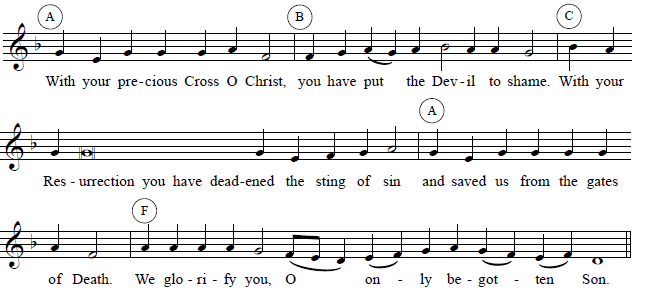The Tone 5 Samohlasen Melody
This is the common melody for singing stichera in tone 5. It consists of two parts, one for the psalm verse and one for the sticheron itself.
Please note: This article assumes that you are familiar with the material taught in an MCI Online course, Introduction to Church Singing. If you have difficulty reading the music notation, please review the MCI website articles on musicianship.
Two Sunday stichera in Tone 5
At Vespers on Saturday evening, while the church is incensed and the lamps are lit, we sing a number of hymns called stichera in honor of the Resurrection; these are inserted after the last few verses of Psalms 129 and 116, and are sung in the Tone of the Week.
Here is the first Sunday sticheron in Tone 5:

The melody consists of four parts, which we call A, B, C, and F (meaning final); here the A phrase is repeated. For a longer sticheron, we repeat the A, B, and C phrases in order, as many times as necessary:

This is the samohlasen sticheron melody in Tone 5. It is used for singing any sticheron in Tone 5 that is not marked with a special melody (podoben)
The sticheron melody
The samohlasen sticheron melody in Tone 5 consists of three phrases, repeated in a regular order, and followed by a concluding phrase.
The A phrase:

is followed by a B phrase

which is followed by a C phrase

After any of these, we can go to the final (F) phrase, which is much more complicated:

Singing this final phrase correctly is the hardest part of the melody.
Singing the A phrase
All four phrases pf this melody have the same basic components: an intonation which begins the phrase; a reciting tone which is used to sing a variable amount of text; a preparatory note to signal the approach of the cadence; and the cadence itself which ends the phrase.
Here is the A phrase, with these parts marked:

Unlike the start of most prostopinije melodies, the accent can fall on any of the first three notes; the cantor uses his or her voice to show where the accent is:

And if necessary, the single note of the cadence is repeated:

Singing the B phrase
Like the A phrase, the B phrase consists of an intonation, reciting tone, preparatory note, and cadence, and begins where the A phrase ended, on do.

The cadence can be slurred, or the middle note repeated if necessary:

The B phrase should always end with a distinctive long–short–long pattern. Make sure the two half notes are the same length; avoid the temptation to add an extra beat to the first one.
Singing the C phrase
The C phrase starts with the same three notes that ended the B phrase:

The final note can be repeated if necessary:

But there's a trick to this phrase. Some Tone 5 music in the Divine Liturgies book (2007) puts the accent at the bottom of the cadence, rather than at the beginning:

In general, later settings such as those in the Liturgy of the Presanctified Gifts book (2010) follow the more traditional pattern, with the accent at the beginning of the cadence. Cantors should be prepared for either possibility!
Singing the final (F) phrase
The final consists of a reciting tone, and a LONG cadence:

The notes outline in blue cause problems for many cantors, either because the half note is held two long, or by slowing down the eighth notes. Remember that a half note plus two eighth notes plus a quarter note should take exactly as long to sing as either of the four-quarter note slurs that follow. Sing the cadence smoothly and the congregation will follow; since it awkwardly and the entire sticheron ends in confusion.
Try "counting out" the rhythm like so, our tapping it while you sing:

Count or tap at a slow even pace, and see how the notes fall into place.
The verse melody
Here is the samohlasen verse melody in Tone 5. Notice how similar the ending is to that of the sticheron melody (above).

Here is two examples, from the Lamplighting Psalms of Vespers:

Putting the two parts together - the Sunday dogmatikon in Tone 5
The last sticheron at the Lamplighting Psalms on an ordinary Saturday evening is called a dogmatikon, because it highlights the dogma or teaching of the Incarnation. Here is the tone 5 dogmatikon, set to the Tone 5 samohlasen melody. The verse is given, followed by the sticheron. Notice how each phrase flows into the next, and how the different text phrases change the way each phrases adapt to different F phrases are used.

Sticheron:

Learning the melody
To learn the melody, practice singing the material on the examples page.


